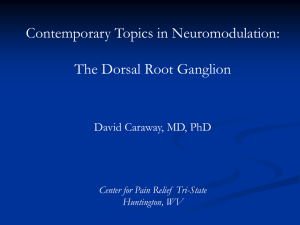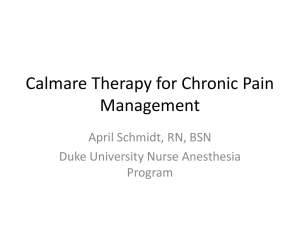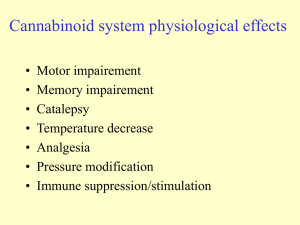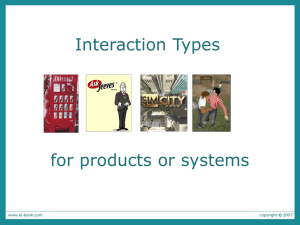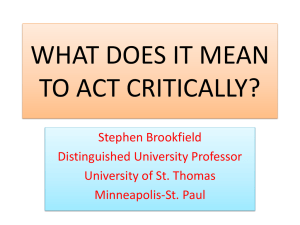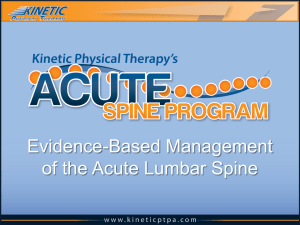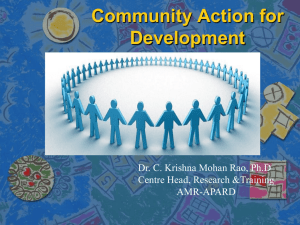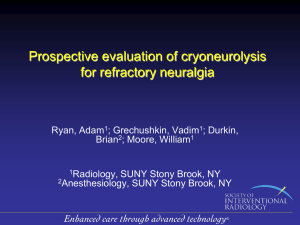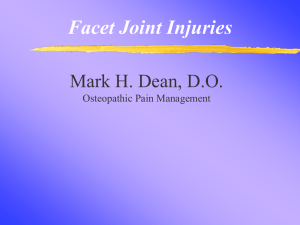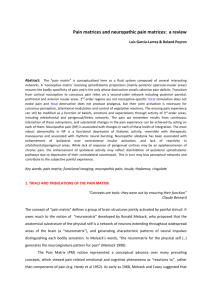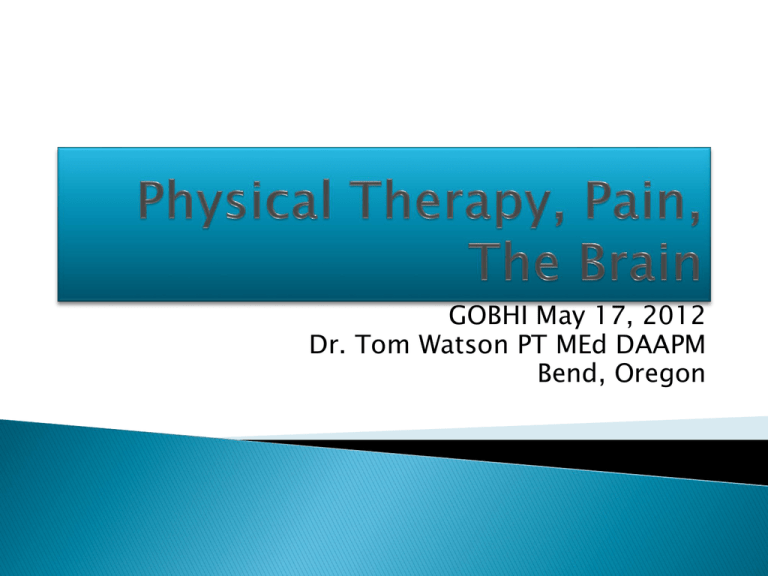
GOBHI May 17, 2012
Dr. Tom Watson PT MEd DAAPM
Bend, Oregon
Dr. Tom Watson DPT PT MEd
Diplomate American Academy
of Pain Management
Rebound Physical Therapy
541-382-7875 Bend, Oregon
painfree@ix.netcom.com
No conflicts of interest
The
mission of the American Academy of Pain
Management is to advance the field of pain
management using an integrative model of
patient-centered care by providing evidencebased education for pain practitioners, as well as
credentialing and advocacy for its members.
http://www.aapainmanage.org/
(209)
533-9744
The 2012 Annual Clinical Meeting will be held in
Phoenix, Arizona, September 20-23, 2012
Founded in 1988, the Academy is the largest pain
management organization in the nation and the
only one that embraces an integrative model of
care, which is patient-centered, focuses on the
“whole” person, is informed by evidence, and
brings together, all appropriate therapeutic
approaches to reduce pain and achieve optimal
health and healing. The Academy offers
continuing education, publications, and
advocacy.
Pain, according to the IASP (International
Association for the Study of Pain), is "an
unpleasant sensory or emotional
experience associated with actual or
potential tissue damage and described in
terms of such damage."
"Pain is a part of being alive, and we need
to learn that. Pain does not last forever,
nor is it necessarily unbeatable, and we
need to be taught that."
– Harold Kushner
The pleasure-pain principle was originated by
Sigmund Freud in modern psychoanalysis,
although Aristotle noted the significance in his
'Rhetoric', more than 300 years BC.
'We may lay it down that Pleasure is a movement,
a movement by which the soul as a whole is
consciously brought into its normal state of
being; and that Pain is the opposite.”
http://changingminds.org/disciplines/psychoanalysis/concepts/pleasure_pain.htm
“Men ought to know that from the brain, and
from the brain only, arise our pleasures, joys,
laughter and jests, as well as our sorrows,
pains, griefs and tears.”
The Sacred Disease, in Hippocrates, trans. W. H. S. Jones
(1923), Vol. 2, 175
National Center for Health Statistics National Household Survey (Aug 2009):
Pain
100 million Americans (not
including Vets and children – IOM 2011)
Diabetes
20.8 million
CAD
18.7 million
Cancer
1.4 million
Pain is the primary reason for visits to a
clinician
Pain always evokes a sensory or
emotional response
When pain occurs, suffering and pain
behaviors follow
A very complex perception- Albert
Schweitzer- “may be worse then death”
Pain is classified in three categories:
1. Acute- lasting 4-6 weeks
2. (Subacute-lasting 6-weeks to 6 months)
3. Chronic pain- starting at six months or
symptoms lasting longer than the
anticipated time for recovery.
Mood
Memory- short and long term
Concentration
Sleep
Sex drive
spontaneous burning pain with an
intermittent sharp stabbing or lancinating
character, an increased pain response to
noxious stimuli (hyperalgesia), pain elicited
by non-noxious stimuli (allodynia)
structural and/or functional nervous system
adaptations secondary to injury
centrally or peripherally –large and small fiber
Diabetic neuropathy
ECT (electro convulsive therapy)
1940s-chronic pain
1957-CRPS I, Retrograde amnesia
RUL (Right Unilateral) ECT without persistent
cognitive side effects
6-12 sessions
Increase in thalamic blood flow, PET Scan
changes in thalamus-parietal-frontal lobes relief of CRPS symptoms
VIT D3, Red Krill Fish Oil
Microcurrent Stimulation, Cold Laser,
Neuro mobilization
Mirror Therapy
NMDR
Hypnosis
Acupuncture
Meds: Opioids, Psychotropic, Neuroleptics,
steroids, non-steroidals
Nociceptive
Mixed
Neuropathic
Caused by
tissue damage
Caused by
combination
of primary
injury and
secondary
effects
Caused by
lesion or dysfunction
in the nervous system
Arthritis
Mechanical low
back pain
Sports/exercise injuries
Postoperative pain
Fractures*
Dislocations*
Postopertive*
Back pain
Fibromyalgia
Cancer pain
Burn pain
Peripheral neuropathy
PHN
Neuropathic low back pain
Radiculopathy
Central poststroke pain
Complex regional pain
syndrome
Central pain -IASP: "pain initiated or caused by a
primary lesion or dysfunction in the central nervous
system" (Merskey, Bogduk, 1994).
Caused by “wind-up” phenomena
Thalamic or other area in Brain
"Neuropathic" vs. "neurogenic", a term used to describe
pain resulting from injury to a peripheral nerve but
without necessarily implying any "neuropathy
"Psychogenic" pain arises due to
maladaptive thought processes
Somatization-bowel disorder, palpitations,
fatigue, respiratory, all disproportionate
Hypochondriasis- fear of condition
Factitious Disorder-Munchausen
syndrome
Pain is transmitted to the brain through
neurological process of nociception
Nociception is pain in which normal nerves
transmit information to the central nervous
system about trauma to tissues (nocere = to
injure, Latin).
Nociception normal nerves transmit
information to the central nervous system
about trauma to tissues (nocere = to injure).
A-beta fibers thickly myelinated mostly
sensory, 10% transmit pain
A-delta fibers thinly myelinated, transmit
sharp/lancinating pain
C-fibers non-myelinated fibers, dull or
chronic pain
Special nerve endings or type IV
mechanoreceptors, i.e. free nerve endings,
absorb chemicals, transfer information to the
spinal cord.
Noxious stimuli via peripheral A delta and C
fibers: release of excitatory amino acid
neurotransmitters (glutamate), neuropeptides, substance P
Nociception occurs with damage to tissue and
chemical or endogenous agents are released
bradykinins, serotonin, cytokines, protons,
sensory neuropeptides, and arachidonic acids:
leukotrienes & prostaglandins, substance P, K+,
ATP
Type IV Mechanoreceptors:
Location: joint capsule, blood vessels,
articular fat pads, anterior dura mater, Ant.
Long. Lig., PLL, connective tissue
NOT in: muscle, Ligamentum flavum, nerve,
articular cartilage
Non-adapting- keep firing until noxious stim
(mechanical, chemical, thermal) removed.
Pain causes: tonic reflexogenic-guarding tonic
muscles proximal to joint-ischemia, no guarding
with phasic muscles
DRG: The free nerve ending in the tip of your
finger that feels the paper cut, cell body in
dorsal root ganglion.
Motor –protective
Perceptual- cross over, pain response can
increase or decrease
Sympathetic- vasoconstriction, sweat,
cool/moist increase output
Remove stimulus- type IV non-adapting,
deformity 3%, thermal below 44.8 C
Emotional, memory, response
70% of all cancer patients have pain, 50% have
severe to intractable pain
Somatic Cancer Pain neoplastic invasion of bone,
joint, muscle, or connective tissue.
Bone Pain direct tumour invasion of bone. Not all
bone metastases are painful
Visceral Cancer Pain. Solid organs - lung, liver, and
kidney parenchyma are insensitive,. Harmful
stimuli ie. burning or cutting of visceral tissue do
not cause pain, whereas natural stimuli such as
hollow organ distension readily produce pain
Neuropathic Cancer Pain- herpes zoster(Shingles)
Congenital Insensitivity to Pain with
Anhidrosis, Hereditary Sensory and
Autonomic Neuropathies (HSAN) (4)
impaired autonomic, sensory, motor
functions
Insensitivity to superficial and deep pain,
neuropathic joints, risk of unrecognized
injury (burns, fractures), corneal ulceration
No cure exists, death
many neurotransmitters in dorsal horns
◦ substance P has a prime role, may promote later
release of EAA
◦ NMDA (glutamate), aspartate, CGRP-facilitates
pain
◦ GABA-pain inhibition
Pain information ascends via spinal thalamic
tract or Lissaurs track, terminates in
thalamus, somatosensory cortex, limbic
system, midbrain, hypothalamus, or
thalamic nuclei.
Facilitation-pathology, environment,
emotional stress
Facilitation-sensory, motor, sympathetic
major descending modulation pathway
originates: periaquaductal gray area, the
locus ceruleus, the nucleus raphe magnus
and the dorsal horn of the spinal cord
terminating in laminae I, II, and IV.
Descending noradrenergic antinociceptive
systems originating in the brainstem
contribute to pain control, in the substantia
gelatinosa of the dorsal horn
Inhibitory- 36 different brain opiods (Korr)
Endorphins- 15-20 minutes of continuous
activity to be produced, half life 6-8 hours
Takes another 15-20 minutes to reach target
site: Axoplasmatic flow of nerves, blood, CSF
via lymphatics
Pharmacological
Cannabis decreases pain-cortical reticular
Alcohol can increase or decrease pain cortical
or rostral reticular
Caffeine-increases- rostral reticular
Barbiturates (Soma) increase cortical reticular
- increase pain
Periaquecductal of Gray: Releases Opiods
receptors: enkephlins, endorphins
Opiods inhibit the neurons that suppress the
activity of Bulbospinal tract
morphine and electrical stimulation produce
potent anti-nociception
High Intensity afferent input: Manipulation, high
frequency e-stim, sex, baroque music, pain
(Grimsby)
Extra Nerve Fibers May Heighten Female Pain
Perception By Jeff Minerd , MedPage Today Staff
Writer, Reviewed by Zalman S. Agus, MD; Emeritus
Professor at the University of Pennsylvania School
of Medicine.
average fiber density in female samples was 34 ±
19 fibers/cm2.
- average density in male samples was 17 ± 8
fibers/cm2 (P=0.038.)
favors physical (organic) not psychosocial
explanation for more pronounced pain perception
in female patients
Pain
“A successful outcome in pain therapy involves
more than the lowering of pain intensity
scores”
Analgesia
Activities of daily living
Adverse effects
Aberrant drug-taking
◦ Pain relief
◦ Psychosocial functioning
◦ Side effects
◦ Addiction-related outcomes
◦ Passik et al. J Support Oncol. 2005;3(1):83-86
.
Where’s Mommy??
Hypnosis- opiate/endorphin release
CBT
Meditation, prayer
Group therapy
midbrain and cortical structures
Personality, gender, age, culture,
fear/avoidance, pre-existing conditions
Interdisciplinary approach-best
MPD/Dis-associative Identity Disorders(DID)
BPD, Bi-Polar
and
Chronic Pain
Symptomatic changes in 1 area may manifest
or decrease other diagnosis
Greeks, Egyptians, Chinese, Romans: Heat,
sun, geodes, eels, massage, manipulation
Modalities-Thermal, Sound ,Traction,
Magnets
Lasers, electrical stimulation
Manual therapies
Therapeutic exercise
Philadelphia Panel Evidence-Based Clinical
Practice Guidelines (EBCPG) in Selected
Rehabilitation Intervention for Low Back Pain
Cochrane Collaboration, and literature review
using meta-analysis and observational
studies
Feel Good:
Heat— Radiant-sun-fire-hot coals-sound
Conductive — Hot water, heated agents
Cold — Ice, chemical freezing agents
High Intensity Afferents-e-stim, TENS, IFC
Pain management in 5 minutes
EVIDENCED BASED:
CES-Microstimulation, Laser
Mercola & Kirsch, "microcurrent electrical
therapy" (MET)
Based on the Arendt-Schultz physics principal of
low intensity stimulation causing profound
biophysical response, Works on the cellular level,
using microamp current
Effective : reducing chronic headaches,improving
serotonin levels, depression, insomnia, chronic
pain, fibromyalgia, PTSD
120 human studies and 19 animal by Daniel
Kirsch, PhD, Mineral Wells, Texas
serotonergic (5-HT) raphe nuclei at brainstem.
5-HT inhibits brainstem cholinergic (ACh) and
noradrenergic (NE) systems that project
supratentorially. Release dopamine
Suppression thalamo-cortical activity, arousal,
agitation, alters sensory processing and
induces EEG alpha rhythm.
5-HT acts directly to modulate pain sensation
in dorsal horn of the spinal cord, alter pain
perception, cognition and emotionality within
the limbic forebrain.
Einstein-1916
Light Amplification by Stimulated Emission
of Radiation: 1950s
Photo-biostimulation principal
Helium neon laser, with 632.8 nm:
Gallium Arsenide or infrared laser 830nm:
◦ superficial wound healing, acute and chronic
pain, with or without inflammation
◦ deep pain, deep wound healing, scar tissue,
calcium deposits, neuropathies
Jedi squirrels of Oregon with light sabers
475+ RCDBCS
Decrease pain, decrease inflammation, increase
healing, Krebs cycle ATP increased by 150% –1000%
Activates mitochondria
Decreases bradykinins-histamine: anti-inflammatory
analgesic
Regenerative: increases mitosis
No thermal effects below 500 mW
6 –12 treatments
www.laser.nu, www.microlightcorp.com
Acute and chronic pain, TMJD
Neuropathies, FMS, Post polio syndrome
Headaches, Arthritis
Acupuncture points
Open wounds
Athletic Injuries: Sprains, Strains, Hematomas
Dorland: manipulation skillful or dexterous
treatment by the hand and in physical therapy,
forceful pressure/movement of a joint within or
beyond its active limit of motion.
Massage, mobilization, manipulation- highly
effective in reducing pain and muscle guarding,
increasing range of motion. Hypermobility or
hypomobility
Manipulation/mobilization date back to
Hippocrates in 460 BC
Basmajian documented “Laying on of hands” in
the Old Testament of the Bible
Andrew Taylor Still introduced osteopathic
manipulation in late 1800s, diseases were
due to abnormal bony situations
Bonesetters were prominent in Mexico and
famous for “stamping or trampling”
techniques that are still practiced today.
Sarah Mapps, aka Crazy Sally or Cross Eyed
Sally, was in high demand in London during
the early 1700s for her “bone setting ability.”
Cyriax disagreed with osteopathic techniques,
advocated manipulation by PT”s
“Hippocrates straightened kyphosis, Galen
replaced outward dislocated vertebrae, and
Pare wrote about subluxation of the spine.”
‘bone setters’ replaced out of place bones,
osteopaths treated the osteopathic lesion,
orthopedic surgeons manipulated the SI
joint, chiropractors replaced subluxed
vertebrae, and neurologist have stretched
the sciatic nerve.”
Soft Tissue Therapies
manual contact, pressure, or movements
primarily to myofascial(soft) tissues
myofascial release, muscle energy,
traditional massage, Rolfing, movement
therapies such as Feldenkrais, Traegering,
PNF, classical massage
manual manipulation of soft tissue
administered for producing effects on
nervous, muscular, lymph, and circulatory
systems
The Ultimate Goal of joint mobilization or
manipulation techniques is to lower the
threshold of activity at a joint or muscle via
dorsal horn inhibition
EMG studies
◦ manipulation/mobilization increased active
range of motion and decreased muscle tone
◦ massage/stretching demonstrated increased
range of motion but increased EMG activity
The musculoskeletal system does not respond
well to immobilization.
The end result is the deterioration and
weakness of the body’s tissue.
Recovery is a slow process and care must be
taken during activity and exercise to avoid
further tissue damage.
For every 1 day in a brace or cast 2 days of
mobilization and exercise
BUFF?
Reducing pain and increasing stability
Programs begin with exercises aimed at
increasing circulation into a muscle,
improving endurance, facilitating
coordination - motion occurs around a
normal physiological axis, increasing strength
and power.
Release endorphins, improve self esteem,
decrease depression
Steps
Phase 1 : coordination, mobility, and stability
around a physiological axis throughout the
range of motion
Phase 2: increasing tissue tolerance to levels
corresponding to the demands of activities
of daily living and restoring function
5000 to 6000 repetitions to regain the
former coordination of the tonic or phasic
muscles in a joint system following an injury
Phase 3: Stabilizing exercises combining
concentric and eccentric contractions
Phase 4: Coordinate tonic and phasic
throughout full AROM such as in PNF
patterns to finalize strengthening and
coordination. Plyometric training.
The patients are pain free and are preparing
to return to their pre-injury levels of activity
or sports participation at this time.
Ball Therapy, Theraband, running, swimming,
skiing, weight lifting
Feldenkrais, Yoga
Pool therapy, Pilates, Plyometrics
Mirror Therapy for CRPS
Dry needling for trigger points
Nutritional counseling, Anti-inflammatory
Diet, Vit D3, Red Krill fish oil
Placebo up to 40%
Eye Movement Desensitization and
Reprocessing (EMDR) or "eye movement
therapy" for anxiety, stress, trauma
The Breakthrough Therapy for Overcoming
Anxiety, Stress, and Trauma by Francine
Shapiro PhD, published 1997
currently fairly widely accepted,
controversial, FMS, chronic pain
equivalent to cognitive behavioral and
exposure therapies
Physical therapy is a skill and an art
Head: learns anatomy, physiology, pain
symptoms, evidence based outcomes various
types of modalities, exercises, and manual
therapies
Hands: apply modalities, manual therapies,
and exercises
Heart: empathy and understanding that pain
patients need more than just modalities and
exercise
Pain does not have to be a
Way of Life
References
• www.heinricher.net/pain_lecture/index.htm
• www.westmeadanaesthesia.org/Meetings/pain-physiology/
Pain%20Physiology.htm
• Weiner’s Pain Management, A Practical Guide for Clinicians, 7th Ed.,
2006,Boswell and Cole Editors, CRC Press, Taylor and Francis Group
LLC, Boca Raton, Fla., chap 36, 3 & 4
• laser.nu
• http://www.sigmaaldrich.com/Area_of_Interest/Life_Science/Cell_
Signaling/Key_Resources/Pathway_Slides__Charts/Ascending_Pain
_Pathway.html
• RUL ECT for Treatment of CRPS: Practical Pain Management Vol 8
#2 March 2008 pps 68-74 (AAPM)
• http://www.associatedphysicians.com/psychology-of-pain.html
References
• Kirsch D, Smith R. The use of cranial electrotherapy stimulation in
the management of chronic pain: a review. Neuro Rehabilitation.
2000;14:85-94.
• Brotman P. Low intensity transcranial electrical stimulation
improves the efficacy of thermal biofeedback and quieting reflex in
the treatment of classical migraine headache. Am J Electromed.
1989;6(5):120-123.
• Philadelphia Panel. Philadelphia Panel evidence-based clinical
practice guidelines on selected rehabilitation interventions for low
back pain. Phys Ther. 2001;81:1641-1674. Review.
• Harris JD. History and development of mobilization and
manipulation. In: Basmajian J. ed. Rational Manual Therapies.
Baltimore: Williams and Wilkins; 1993:7-22.


